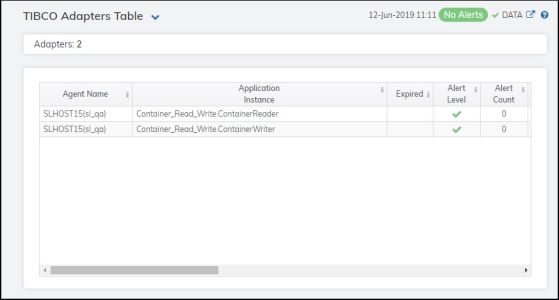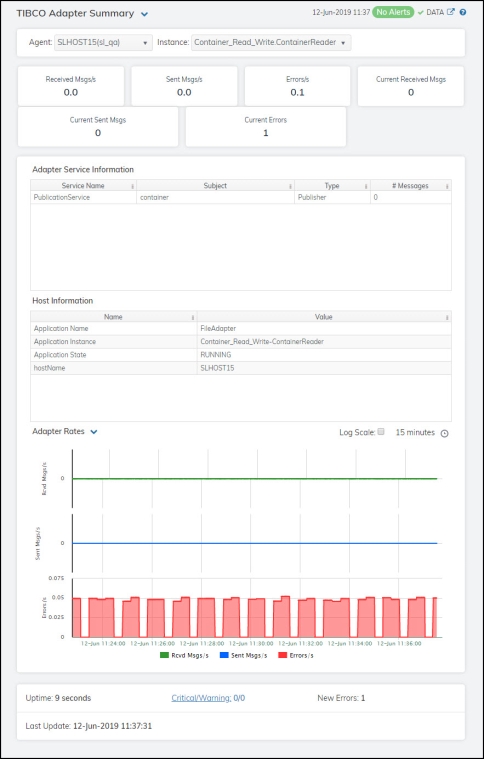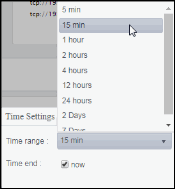All Adapters View
These displays provide detailed data for all adapters or for a particular adapter. Clicking All Adapters from the left/navigation menu opens the TIBCO Adapters Table display, which shows a tabular view of your adapters and their associated metrics. The options available under All Adapters are:
| • | All Adapters Heatmap: Opens the TIBCO Adapters Heatmap display, which provides a view of all adapters in a heatmap format and their associated metrics. |
| • | Single Adapter: Opens the TIBCO Adapter Summary display, which provides current and historical data for a single adapter. |
TIBCO Adapters Table
The table in this display provides a view of all of your adapters and their associated metric data including agent, application instance, alert severity, alert count, and the current value of each gathered metric. You can click a column header to sort column data in numerical or alphabetical order, and drill-down and investigate by double-clicking a row to view details for the selected adapter in the TIBCO Adapter Summary display

Note: Fields/columns with an asterisk (*) at the end of the field/column definition contain data that is provided by the selected adapter. Refer to TIBCO Adapter documentation for more information regarding these fields.
|
Fields and Data: |
||||
|
|
Adapters |
The total number of adapters listed in the table. |
||
|
All Adapters Table: |
||||
|
|
Agent Name |
The name of the agent. |
||
|
|
Application Instance |
The name of the application instance. |
||
|
|
Alert Level |
The current alert severity.
|
||
|
|
Alert Count |
The total number of alerts for the host. |
||
|
|
Adapter Name |
The name of the adapter.* |
||
|
|
Received Msgs |
The number messages received.* |
||
|
|
Sent Msgs |
The total number of messages sent.* |
||
|
|
Total Errors |
The total number of errors.* |
||
|
|
Total Errors/s |
The number of errors per second.* |
||
|
|
Sent Msgs/s |
The number of messages sent per second.* |
||
|
|
New Errors |
The number of new errors received since the last polling update.* |
||
|
|
Process ID |
The process ID of TIBCO Adapter you are running.* |
||
|
|
Current Sent Msgs |
The increase in the number of messages sent (from the previous polling period to the current polling period).* |
||
|
|
Last Restart |
The date and time the adapter was last restarted.* |
||
|
|
Current Received Msgs |
The increase in the number of messages received (from the previous polling period to the current polling period).* |
||
|
|
Current Total Errors |
The increase in the number total errors (from the previous polling period to the current polling period).* |
||
|
|
Received Msgs/s |
The number of messages received per second.* |
||
|
|
Expired |
When checked, performance data has not been received within the time specified (in seconds) in the Expire Time field in the Duration region in the RTView Configuration Application > (Project Name) > Solution Package Configuration > TIBCO Adapters > DATA STORAGE tab. The Delete Time field (also in the Duration region) allows you to define the amount of time (in seconds) in which the row will be removed from the table if there is no response. |
||
|
|
Timestamp |
The date and time the row data was last updated. |
||
TIBCO Adapters Heatmap
Clicking All Adapters Heatmap in the left/navigation menu opens the TIBCO Adapters Heatmap, which provides an easy-to-view interface that allows you to quickly identify the current status of each of your adapters for each available metric. You can view the adapters in the heatmap based on the following metrics: the current alert severity, the current alert count, the messages received rate, the messages sent rate, the current messages sent (since the last data update), the current messages received (since the last data update), and the increase in errors (since the last data update). By default, this display shows the heatmap based on the Alert Severity metric.
Each rectangle in the heatmap represents an adapter. The rectangle color indicates the most critical alert state associated with the adapter. Choose a different metric to display from the Metric drop-down menu. Mouse over a rectangle to see additional metrics. By default, this display shows Alert Severity.
You can use the Show Agent check-box  to include or exclude labels in the heatmap, and you can mouse over a rectangle to see additional metrics for an adapter. Drill-down and investigate an engine by clicking a rectangle in the heatmap to view details in the TIBCO Adapter Summary display.
to include or exclude labels in the heatmap, and you can mouse over a rectangle to see additional metrics for an adapter. Drill-down and investigate an engine by clicking a rectangle in the heatmap to view details in the TIBCO Adapter Summary display.

|
Fields and Data: |
||||
|
|
Adapters |
The number of adapters included in the display. |
||
|
|
Show Agent |
Select this check box to display the names of the agents at the top of each rectangle in the heatmap. |
||
|
|
Log Scale |
Select this check box to enable a logarithmic scale. Use Log Scale to see usage correlations for data with a wide range of values. For example, if a minority of your data is on a scale of tens, and a majority of your data is on a scale of thousands, the minority of your data is typically not visible in non-log scale graphs. Log Scale makes data on both scales visible by applying logarithmic values rather than actual values to the data. |
||
|
|
Auto Scale |
Select to enable auto-scaling. When auto-scaling is activated, the color gradient bar's maximum range displays the highest value. Note: Some metrics auto-scale automatically, even when Auto Scale is not selected. |
||
|
|
Metric |
Select the metric driving the heatmap display. The default is Alert Severity. Each Metric has a color gradient bar that maps values to colors. The heatmap organizes the servers by agent, where each rectangle represents an adapter. Mouse-over any rectangle to display the current values of the metrics for the adapter. Click on a rectangle to drill-down to the associated TIBCO Adapter Summary display for a detailed view of metrics for that particular adapter. |
||
|
|
|
Alert Severity |
The current alert severity. Values range from 0 - 2, as indicated in the color gradient
|
|
|
|
|
Alert Count |
The total number of critical and warning unacknowledged alerts in the adapters. The color gradient |
|
|
|
|
Sent Msgs/s |
The number of message sent per second. The color gradient bar When Auto Scale is checked, the numeric values in the color gradient bar show the range of the data being displayed rather than the default values. The middle value changes accordingly to indicate the color of the middle value of the range. |
|
|
|
|
Received Msgs/s |
The number of messages received per second. The color gradient When Auto Scale is checked, the numeric values in the color gradient bar show the range of the data being displayed rather than the default values. The middle value changes accordingly to indicate the color of the middle value of the range. |
|
|
|
|
Current Sent Msgs |
The increase in the number of messages sent (per second) from the previous polling period to the current polling period. The color gradient The Auto Scale check box does not impact this metric. |
|
|
|
|
Current Received Msgs |
The increase in the number of messages received (per second) from the previous polling period to the current polling period. The color gradient The Auto Scale check box does not impact this metric. |
|
|
|
|
Current Errors |
The increase in the number of errors from the previous polling period to the current polling period. The color gradient When Auto Scale is checked, the numeric values in the color gradient bar show the range of the data being displayed rather than the default values. The middle value changes accordingly to indicate the color of the middle value of the range. |
|
TIBCO Adapter Summary
Clicking Single Adapter in the left/navigation menu opens the TIBCO Adapter Summary display, which allows you to view current as well as trending data for a single adapter. Clicking on the information boxes at the top of the display takes you to the TIBCO Adapters Table display, where you can view additional adapter data. You can view message statistics, adapter service information, and host information for a specific instance.
The trend graph has two options: Adapter Rates and Adapter Current Counts. Adapter Rates traces the current and historical rate of messages received, rate of messages sent, and rate of errors over a selected time range. Adapter Current Counts traces current and historical messages received, messages sent, and number of errors over a selected time range.
Clicking the Critical/Warning link at the bottom of the display opens the Alerts Table by Component display.

Note: Fields/columns with an asterisk (*) at the end of the field/column definition contain data that is provided by the selected adapter. Refer to TIBCO Adapter documentation for more information regarding these fields.
|
Filter By: |
||||
|
|
Agent |
Select the agent for which you want to show data in the display. |
||
|
|
Instance |
Select the instance for which you want to show data in the display. |
||
|
Fields and Data: |
||||
|
|
Received Msgs/s |
The number of messages received per second on the adapter.* |
||
|
|
Sent Msgs/s |
The number of messages sent per second from the adapter.* |
||
|
|
Errors/s |
The number of errors occurring per second on the adapter.* |
||
|
|
Current Received Msgs |
The increase in the number of messages received since the last polling update.* |
||
|
|
Current Sent Msgs |
Deltas -- The increase in the number of messages sent since the last polling update.* |
||
|
|
Current Errors |
The increase in the number of errors since the last polling update.* |
||
|
Adapter Service Information Table |
||||
|
|
Service Name |
The name of the service.* |
|
|
|
|
Subject |
The name of the subject.* |
|
|
|
|
Type |
The type of adapter service.* |
||
|
|
# Messages |
The current number of messages.* |
||
|
Host Information Table |
||||
|
|
Name |
The name of the host.* |
||
|
|
Value |
The host’s value.* |
||
|
Trend Graphs |
Adapter Rates Rcvd Msgs/s -- traces rate of messages received. Sent msgs/s-- traces the rate of messages sent. Errors/s -- traces the rate of errors. Adapter Current Counts Rcvd Msgs -- traces the increase in the number of messages received since the last polling update. Sent Msgs -- traces the increase in the number of messages sent since the last polling update. Errors -- traces the increase in the number of errors since the last polling update. |
|||
|
|
|
Log Scale |
Select to enable a logarithmic scale. Use Log Scale to see usage correlations for data with a wide range of values. For example, if a minority of your data is on a scale of tens, and a majority of your data is on a scale of thousands, the minority of your data is typically not visible in non-log scale graphs. Log Scale makes data on both scales visible by applying logarithmic values rather than actual values to the data. |
|
|
|
|
Time Settings |
Select a time range from the drop down menu varying from 5 Minutes to Last 7 Days. By default, the time range end point is the current time.
To change the time range, deselect the now toggle, which displays some additional date fields. You can click the left and right arrow buttons to decrease the end time by one time period (the time selected in the Time range drop down) per click, or you can choose the date and time from the associated calendar and clock icons. You can also enter the date and time in the text field using the following format: MMM dd, YYYY HH:MM:ss. For example, Aug 21, 2018 12:24 PM. Click the now toggle to reset the time range end point to the current time.
|
|
|
Uptime |
The amount of time the adapter has been up and running. |
|||
|
Critical/Warning |
The number of critical and warning errors. |
|||
|
New Errors |
The number of erorrs since the last data update. |
|||
|
Last Update |
The date and time in which the data in the display was last updated. |
|||













